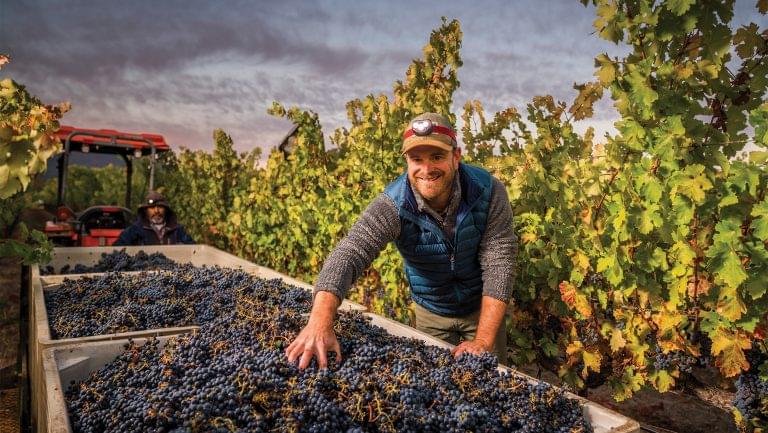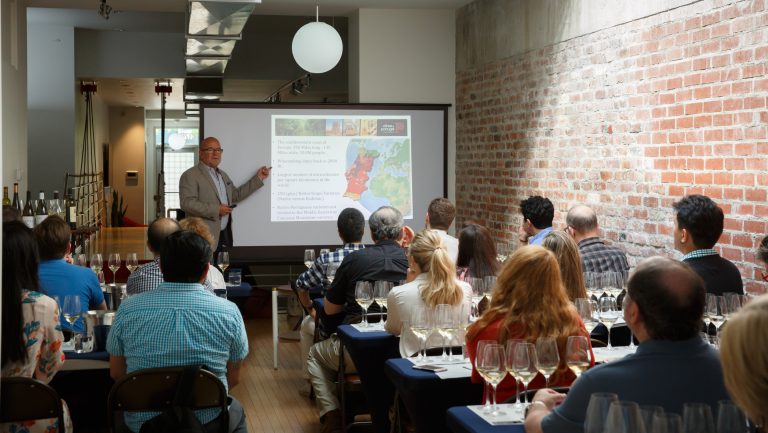This advertising content was produced in collaboration with SevenFifty and our partner, Sequoia Grove.
California’s giant sequoia trees are renowned for their longevity and ability to connect to their environment, neighboring trees, and remote water sources. In Rutherford, Sequoia Grove is built on that same philosophy of connection and interdependence.
“We are a Cabernet Sauvignon-based brand that is really terroir-driven,” explains winemaker Molly Hill, who has been with Sequoia Grove since 2003. “Our vision is to produce wines that have an overall balance to them where all of the components that make up wine are beautifully integrated.”
Hill’s philosophy is a holistic expansion of Sequoia Grove’s long-standing ethos: Since its founding in 1979, this Napa mainstay has become rooted in its terroir while embracing a philosophy that empowers innovation. Today with Hill and viticulturist Jake Terell at the wheel, the brand is well-positioned to expand their towering Cabernet Sauvignon legacy.

Don’t miss the latest drinks industry news and insights. Sign up for our award-winning newsletters and get insider intel, resources, and trends delivered to your inbox every week.
There is a wealth of institutional knowledge embedded within the Sequoia Grove headquarters on the famed Rutherford Bench: In the winery’s early days, more than 40 years ago, renowned winemaker Andre Tchelistcheff consulted with Sequoia Grove to establish an unshakable foundation for high-quality Cabernet Sauvignon and Chardonnay. Now, Hill and Terrell are expanding on this deep understanding of Sequoia Grove’s terroirs with the help of modern technology.

Cultivating Legacy Vineyards
“I think the central appellations of Napa Valley, Rutherford, and Yountville are really the key places to invest in,” explains Hill. “These areas have really lovely soil on the valley floor, and this area is really what helped put Napa Valley Cabernet on the map.”
In each of Sequoia Grove’s three estate vineyard sites—two in Rutherford and one in Yountville—and their original 24-acre estate vineyard, Terrell has emphasized understanding the respective terroirs of each vineyard block by extensively mapping exposures and conducting comprehensive soil sampling. Armed with new data about Sequoia Grove’s historic sites, Hill and Terrell have replanted the famed vineyards to diverse selections of clones and rootstocks, grounding Sequoia Grove’s legacy in prime Napa Valley terroir.
In 2008, Sequoia Grove acquired the 50-acre Tonella Vineyard in Rutherford—already a well-known and long-time source of Cabernet Sauvignon and Cabernet Franc for their Napa Valley Cabernet—and began replanting the heritage vineyard to a diverse selection of clones and rootstocks ideally suited to Rutherford’s gravelly loam soils. In June 2021, the winery also acquired the renowned State Lane Vineyard in Yountville.
“I really think that our three estate vineyards are going to allow Sequoia Grove to weather the changes that everyone in the valley is facing from climate change,” explains Hill.. “It’s my role to listen to the site and listen to the vintage to really coax out the flavor profile of each wine.”

Investing in Quality
In a collaborative effort to give Hill the maximum ability to interpret Sequoia Grove’s combination of terroir, vintage, and variety, the estate fully updated their winemaking facility in 2018, installing state-of-the-art sorting equipment, presses, and an in-house barrel cellar.
“When we’re making wine we want to pick every lot at the peak of ripeness, when the terroir expression is at the forefront,” explains Hill, who now has access to a dedicated tank for each vineyard block plus automations that allow for rapid berry sorting, gentler winemaking, and automatic pump-overs.
“With the new winery, we updated how quickly we can process the fruit, and that has been wonderful to pivot into,” she says. “Now that we have our variables more controlled, we can pick everything at optimal ripeness, and we can do it with greater focus and intention.”
Aging in French oak encourages balance in the final wines, which speak wholly to their Napa Valley terroir and the majesty of Cabernet Sauvignon. Classically structured and deep in color, the 2018 Sequoia Grove Cabernet Sauvignon currently in the market segues seamlessly from dark fruit to baking spices before closing with Rutherford’s signature, finely grained finish.
“We were so fortunate that the first vintage we got to produce in our new facility was the 2018,” says Hill. “It was a really phenomenal growing season. We had solid rainfall and a very slow, steady growing season, so we had extended ripening and hang-time. Those wines, I think, are very classic Napa Valley wines.”
Yet Sequoia Grove’s devotion to their ecosystem doesn’t stop once the vines are established and the wine is bottled: Their commitment to conscientious, sustainable, high-quality farming is a year-round affair. The estate partners with Save the Redwoods League to preserve and protect endangered sequoia and redwood forests, and it holds Napa Green Winery, Vineyard, and Fish Friendly Farming certifications. Today, 100 percent of their energy is sourced from renewable resources—a significant investment in sustainability few estates can claim.
The estate likewise invests judiciously in its human capital—a key resource Hill cites as integral to the estate’s success and to crafting the best possible wines.
“Before all of these improvements, it was a real challenge to manage our time and give the same focus and attention to each lot as it came into the winery during harvest,” she says. “At the end of the day, when your entire team is comfortable, and they feel like they’re able to do their best work with the state of the art tools, that is really beneficial.”
With an all-consuming commitment to innovation and Cabernet Sauvignon excellence, Sequoia Grove has fostered an environment that honors their roots in the region, yet is poised to withstand and adapt to the constant fluctuations of the global wine environment. In doing so, the estate has built a vinous legacy that honors their namesake flora with the giant sequoia’s timeless, classic charm.

Dispatch
Sign up for our award-winning newsletter
Don’t miss the latest drinks industry news and insights—delivered to your inbox every week.










